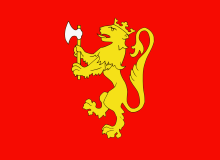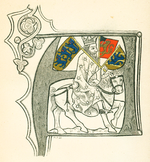
The national flag of Denmark is red with a white Nordic cross, which means that the cross extends to the edges of the flag and the vertical part of the cross is shifted to the hoist side.

A national flag is a flag that represents and symbolizes a given nation. It is flown by the government of that nation, but can also be flown by its citizens. A national flag is typically designed with specific meanings for its colours and symbols, which may also be used separately from the flag as a symbol of the nation. The design of a national flag is sometimes altered after the occurrence of important historical events. The burning or destruction of a national flag is a greatly symbolic act.

The national flag of Sweden consists of a yellow or gold Nordic cross on a field of light blue. The Nordic cross design traditionally represents Christianity. The design and colours of the Swedish flag are believed to have been inspired by the present coat of arms of Sweden of 1442, which is blue divided quarterly by a cross pattée of gold. Blue and yellow have been used as Swedish colours at least since Magnus III's royal coat of arms of 1275.

The House of Bernadotte is the royal family of Sweden, founded there in 1818 by King Charles XIV John of Sweden. It was also the royal family of Norway between 1818 and 1905. Its founder was born in Pau in southern France as Jean Bernadotte. Bernadotte, who had been made a General of Division and Minister of War for his service in the French Army during the French Revolution, and Marshal of the French Empire and Prince of Ponte Corvo under Napoleon, was adopted by the elderly King Charles XIII of Sweden, who had no other heir and whose Holstein-Gottorp branch of the House of Oldenburg thus was soon to be extinct on the Swedish throne. The current king of Sweden, Carl XVI Gustaf, is a direct descendant of Charles XIV John.

The national flag of Norway is red with a navy blue Scandinavian cross bordered in white that extends to the edges of the flag; the vertical part of the cross is shifted to the hoist side in the style of the Dannebrog, the flag of Denmark.

Sweden and Norway or Sweden–Norway, officially the United Kingdoms of Sweden and Norway, and known as the United Kingdoms, was a personal union of the separate kingdoms of Sweden and Norway under a common monarch and common foreign policy that lasted from 1814 until its peaceful dissolution in 1905.

The coat of arms of the United Kingdom are the arms of dominion of the British monarch. They are both the personal arms of the monarch, currently King Charles III, and the arms of the state. In addition to the monarch, the arms are used by state institutions including the Government of the United Kingdom, the Parliament of the United Kingdom, and the British judiciary. Differenced versions of the arms are used by members of the British royal family. The monarch's official flag, the Royal Standard, is the coat of arms in flag form.
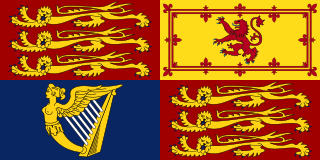
The royal standards of the United Kingdom presently refer to either of two similar flags used by King Charles III in his capacity as sovereign of the United Kingdom, the Crown dependencies, and the British Overseas Territories. Two versions of the flag exist, one for use within Scotland and the other for use elsewhere.

Three Crowns is the national emblem of Sweden, present in the coat of arms of Sweden, and composed of three yellow or gilded coronets ordered two above and one below, placed on a blue background. Similar designs are found on a number of other coats of arms or flags.

Prince Wilhelm, Duke of Södermanland was a Swedish and Norwegian prince. He authored many books as Prins Wilhelm.
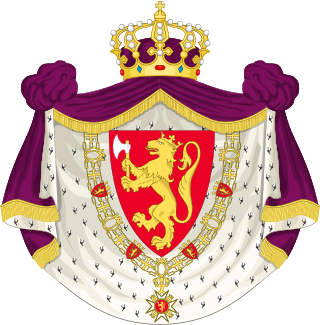
The coat of arms of Norway is the arms of dominion of King Harald V of Norway, and as such represents both the monarch and the kingdom. It depicts a standing golden lion on a red background, bearing a golden crown and axe with silver blade.
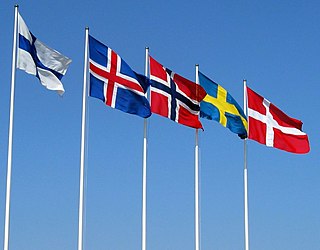
A Nordic cross flag is a flag bearing the design of the Nordic or Scandinavian cross, a cross symbol in a rectangular field, with the centre of the cross shifted towards the hoist.

Members of the Norwegian royal family are people related to King Harald V of Norway or former Norwegian monarchs. The current family who holds the throne are members of the House of Glücksburg who ascended to the Norwegian throne after the election of Prince Carl of Denmark as King of Norway during the dissolution of the Swedish-Norwegian union in 1905.

The coat of arms of Denmark has a lesser and a greater version.

The Norwegian monarch is the head of state of Norway, which is a constitutional and hereditary monarchy with a parliamentary system. The Norwegian monarchy can trace its line back to the reign of Harald Fairhair and the previous petty kingdoms which were united to form Norway; it has been in unions with both Sweden and Denmark for long periods.

The union mark of Norway and Sweden was a symbol of the Union between Sweden and Norway. It was inserted into the canton of the Swedish and Norwegian national flags from 1844 to denote the partnership of the two countries in a personal union. The mark combined the flag colours of both kingdoms, equally distributed, to reflect their equal status within the union. The stand-alone design of the mark was used for the diplomatic flag and the naval jack of the union. The union mark remained part of the flags of both countries until it was removed from the merchant and state flags of Norway in 1899 because of increasing Norwegian dissatisfaction with the union. It remained on the naval ensign of Norway and all Swedish flags until the dissolution of the union between Norway and Sweden in 1905.
This lists those feudal magnates who have held Halland (Hallandia) as fief, or its southern or northern part, as a substantive title.

The flags of the Dutch royal family are a set of flags used to identify a member of the royal family. The current system of flags for the Dutch monarch, princes, and princesses was introduced in 1908.

Hjalmar Eilif Emanuel Peterssen was a Norwegian painter. He is most commonly associated with his landscapes and portraits. He gained early recognition for the history painting Christian II signing the Death Warrant of Torben Oxe and established himself as one of Norway's foremost portrait painters, with portraits of, among others, Henrik Ibsen and Edvard Grieg. He also became known for his landscape paintings, and became part of the artist circle known as the Skagen Painters. He also became known for his design in 1905 of Norway's national coat of arms with the Norwegian lion, which was used by the government and the royal house. The design is still used in the royal coat of arms and the royal flag.

The standard of Prince Philip, Duke of Edinburgh, was the personal flag used by Prince Philip, Duke of Edinburgh. It displays his coat of arms and can thus be considered a banner of arms.
